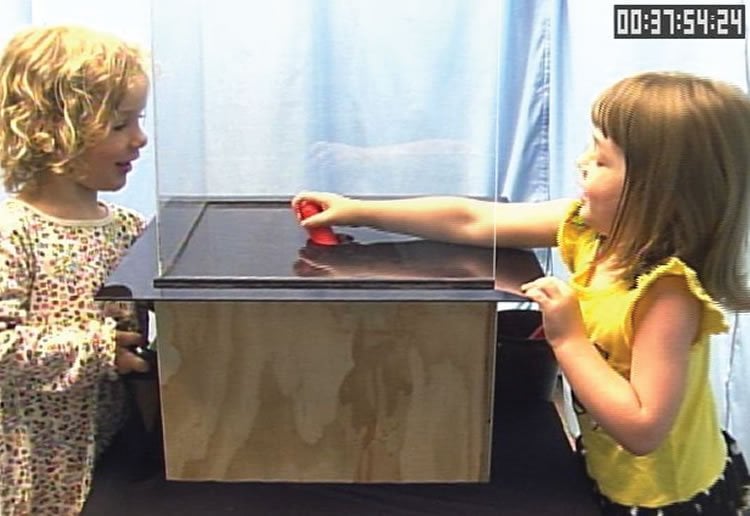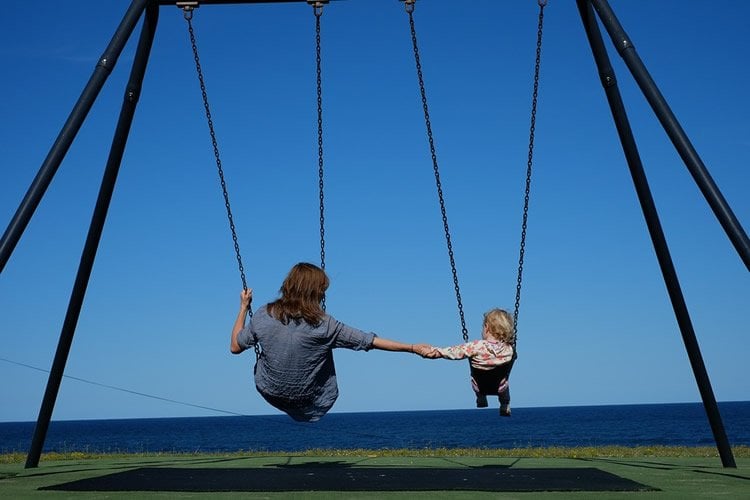Summary: Researchers report synchronous movement generated by playing on the swings can encourage young children to cooperate in other activities.
Source: University of Washington.
A favorite childhood pastime — swinging on the playground swing set — also may be teaching kids how to get along.
The measured, synchronous movement of children on the swings can encourage preschoolers to cooperate on subsequent activities, University of Washington researchers have found.
A study by the UW’s Institute for Learning & Brain Sciences (I-LABS) shows the potential of synchronized movement in helping young children develop collaborative skills. The study is published online in the Journal of Experimental Child Psychology.
“Synchrony enhances cooperation, because your attention is directed at engaging with another person, at the same time,” explained Tal-Chen Rabinowitch, a postdoctoral researcher at I-LABS. “We think that being ‘in time’ together enhances social interaction in positive ways.”
Previous studies, including others by Rabinowitch, have linked music and being in sync with other pro-social behaviors, such as helping, sharing and empathizing, among young children: Marching together to a song, for example, might prompt one child to share with another. In this study, Rabinowitch, along with I-LABS co-director and psychology professor Andrew Meltzoff, sought to focus on movement alone, without music, and examined how children cooperated with one another afterward.

Cooperation — adapting to a situation, compromising with someone else, working toward a common goal — is considered a life skill, one that parents and teachers try to develop in a child’s early years.
For the I-LABS study, researchers built a swing set that enabled two children to swing in unison, in controlled cycles of time. Pairs of 4-year-olds — who were unfamiliar to one another — were randomly assigned to groups that either swung together in precise time, swung out of sync with each other, or didn’t swing at all. The pairs in all three groups then participated in a series of tasks designed to evaluate their cooperation. In one activity, the children played a computer game that required them to push buttons at the same time in order to see a cartoon figure appear. Another, called the “give and take” activity, involved passing objects back and forth through a puzzle-like device.

Researchers found that the children who swung in unison completed the tasks faster, indicating better cooperation than those who swung out of sync, or not at all. On the button-push task, for instance, the pairs who had been swinging together showed a greater tendency to strategically raise their hands before they pushed the button so as to signal their intent to the other child, which proved to be a successful tactic for the task.
For 4-year-olds, moving in sync can create a feeling of “being like” another child that, consequently, may encourage them to communicate more and try to work together, Rabinowitch said.
“Cooperation has both a social and cognitive side, because people can solve problems they couldn’t solve alone,” Meltzoff said. “We didn’t know before we started the study that cooperation between 4-year-olds could be enhanced through the simple experience of moving together. It’s provocative that kids’ cooperation can be profoundly changed by their experiences.”
Rabinowitch believes the results of this study can have implications outside the lab. Teachers and parents can provide “in sync” opportunities for groups of children, whether through music, dance or play.
Funding: The study was funded by a Fulbright Postdoctoral Fellowship, along with grants from the Grammy Foundation, the Bezos Family Foundation and the Robert L Richmond Foundation.
Source: Kim Eckart – University of Washington
Image Source: NeuroscienceNews.com image is of the girls is credited to I-LABS. The swing image is in the public domain.
Original Research: Abstract for “Synchronized movement experience enhances peer cooperation in preschool children” by Tal-Chen Rabinowitch and Andrew N. Meltzoff in Journal of Experimental Child Psychology. Published online April 13 2017 doi:10.1016/j.jecp.2017.03.001
[cbtabs][cbtab title=”MLA”]University of Washington “Playing on the Swings Helps Kids Learn to Cooperate.” NeuroscienceNews. NeuroscienceNews, 21 April 2017.
<https://neurosciencenews.com/playing-cooperation-6477/>.[/cbtab][cbtab title=”APA”]University of Washington (2017, April 21). Playing on the Swings Helps Kids Learn to Cooperate. NeuroscienceNew. Retrieved April 21, 2017 from https://neurosciencenews.com/playing-cooperation-6477/[/cbtab][cbtab title=”Chicago”]University of Washington “Playing on the Swings Helps Kids Learn to Cooperate.” https://neurosciencenews.com/playing-cooperation-6477/ (accessed April 21, 2017).[/cbtab][/cbtabs]
Abstract
Synchronized movement experience enhances peer cooperation in preschool children
Cooperating with other people is a key achievement in child development and is essential for human culture. We examined whether we could induce 4-year-old children to increase their cooperation with an unfamiliar peer by providing the peers with synchronized motion experience prior to the tasks. Children were randomly assigned to independent treatment and control groups. The treatment of synchronous motion caused children to enhance their cooperation, as measured by the speed of joint task completion, compared with control groups that underwent asynchronous motion or no motion at all. Further analysis suggested that synchronization experience increased intentional communication between peer partners, resulting in increased coordination and cooperation.
“Synchronized movement experience enhances peer cooperation in preschool children” by Tal-Chen Rabinowitch and Andrew N. Meltzoff in Journal of Experimental Child Psychology. Published online April 13 2017 doi:10.1016/j.jecp.2017.03.001






